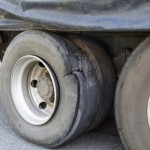Safe Tires Mean Safe Travels
 You probably see them all the time; shredded rubber laying across the highway as obstacles for motorists to avoid. It has probably even happened to your rig tires at some point. Thank goodness for dual tires. Regardless, knowing the signs when the time is right to replace your rig tires is always helpful for the best preparation.
You probably see them all the time; shredded rubber laying across the highway as obstacles for motorists to avoid. It has probably even happened to your rig tires at some point. Thank goodness for dual tires. Regardless, knowing the signs when the time is right to replace your rig tires is always helpful for the best preparation.
Before each haul, you should inspect all tires personally, as the driver. Not only should you inspect the tires on your cab, but the trailer itself to ensure the safety of your haul and fellow drivers. A short inspection of all 18 tires could also save damage to not only your rig, but to the motorists who may not see the tire debris.
Cupping
When your tires show inward dents, or ‘cups,’ it’s an indication of weak spots. They are soft and completely vulnerable to rupturing. It’s a phenomenon which occurs when tires are not regularly rotated. If you detect any cupping spots, seek a tire change before proceeding another mile.
Tread Depth
Ensuring your tread depth and protecting against flat spots is crucial. When these are present, it means the rubber is wearing this and very little literally sits between you and a complete tire blowout. Ensuring tread depth is also especially crucial in the icy winter months to protecting from losing traction and sliding off the highway.
Bulges
If you are experiencing vibration, or even if you aren’t, you may have tire bulges. These might be the most dangerous sign of tire wear. Like cupping, these are an indication of weak spots, but they are especially vulnerable because they bulge outward rather than in. They present a larger target to the vulnerabilities and imperfections in the worn tire.
If you notice any of these indication of wear upon a short tire inspection, protect your life and that of those around you and request a tire change. Or if you notice at a weigh station or rest stop, do it yourself. Keep the roads safe and keep on truckin’.
